Contemporary People Management: Skills and Development Report
VerifiedAdded on 2022/11/13
|7
|2070
|381
Report
AI Summary
This report delves into the core aspects of contemporary people management, with a specific focus on learning and development as a critical component. It emphasizes the shift from viewing training as a cost to recognizing it as a vital investment in human capital, leading to increased employee performance, loyalty, and innovation. The report explores the impact of skilled workforces on organizational success, productivity, and customer satisfaction. It highlights the importance of continuous training, the application of the ADDIE model, and the significance of aligning training programs with organizational needs. The report concludes by underscoring the benefits of investing in employee development to achieve long-term profitability and competitive advantage in today's dynamic business environment.
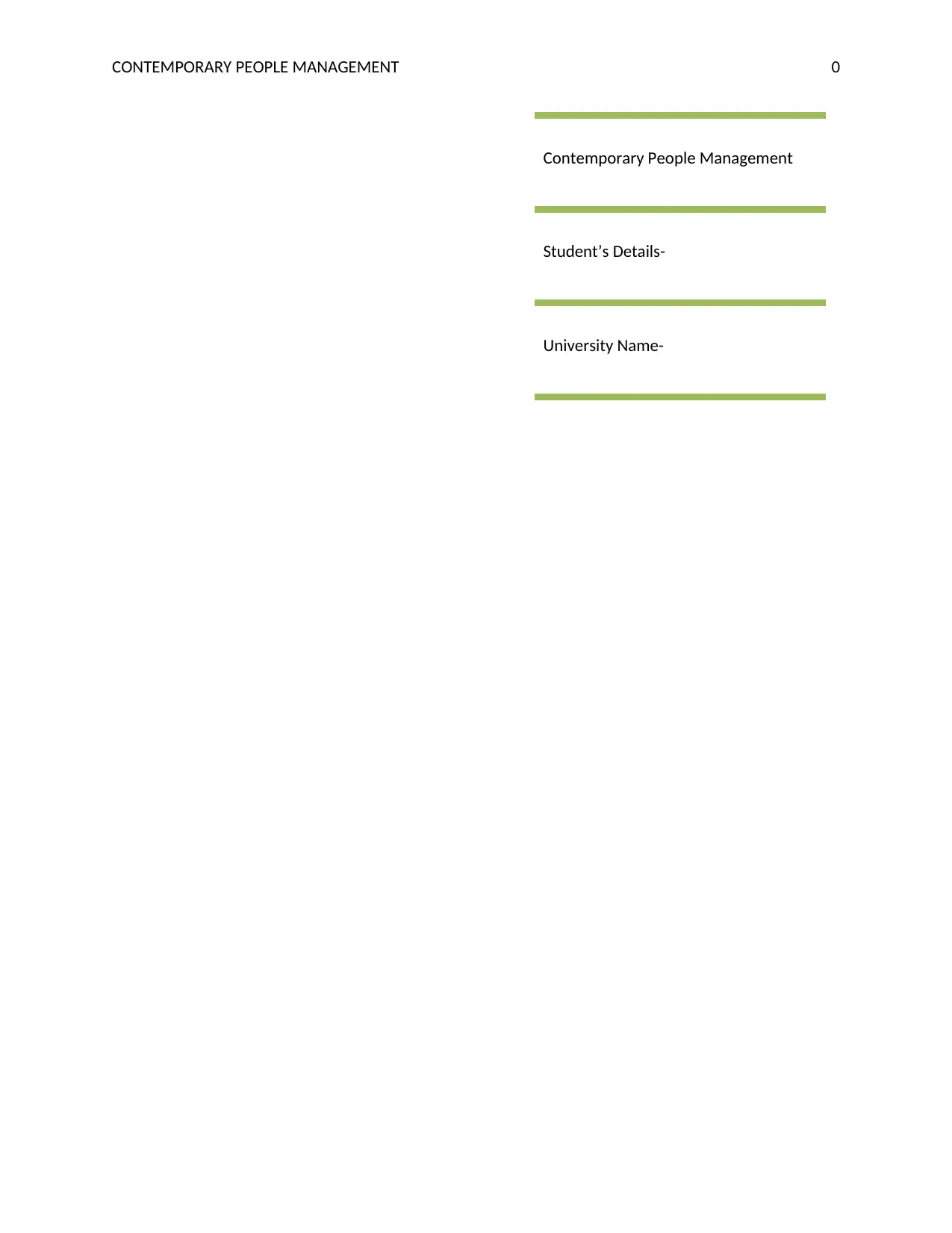
CONTEMPORARY PEOPLE MANAGEMENT 0
Contemporary People Management
Student’s Details-
University Name-
Contemporary People Management
Student’s Details-
University Name-
Paraphrase This Document
Need a fresh take? Get an instant paraphrase of this document with our AI Paraphraser
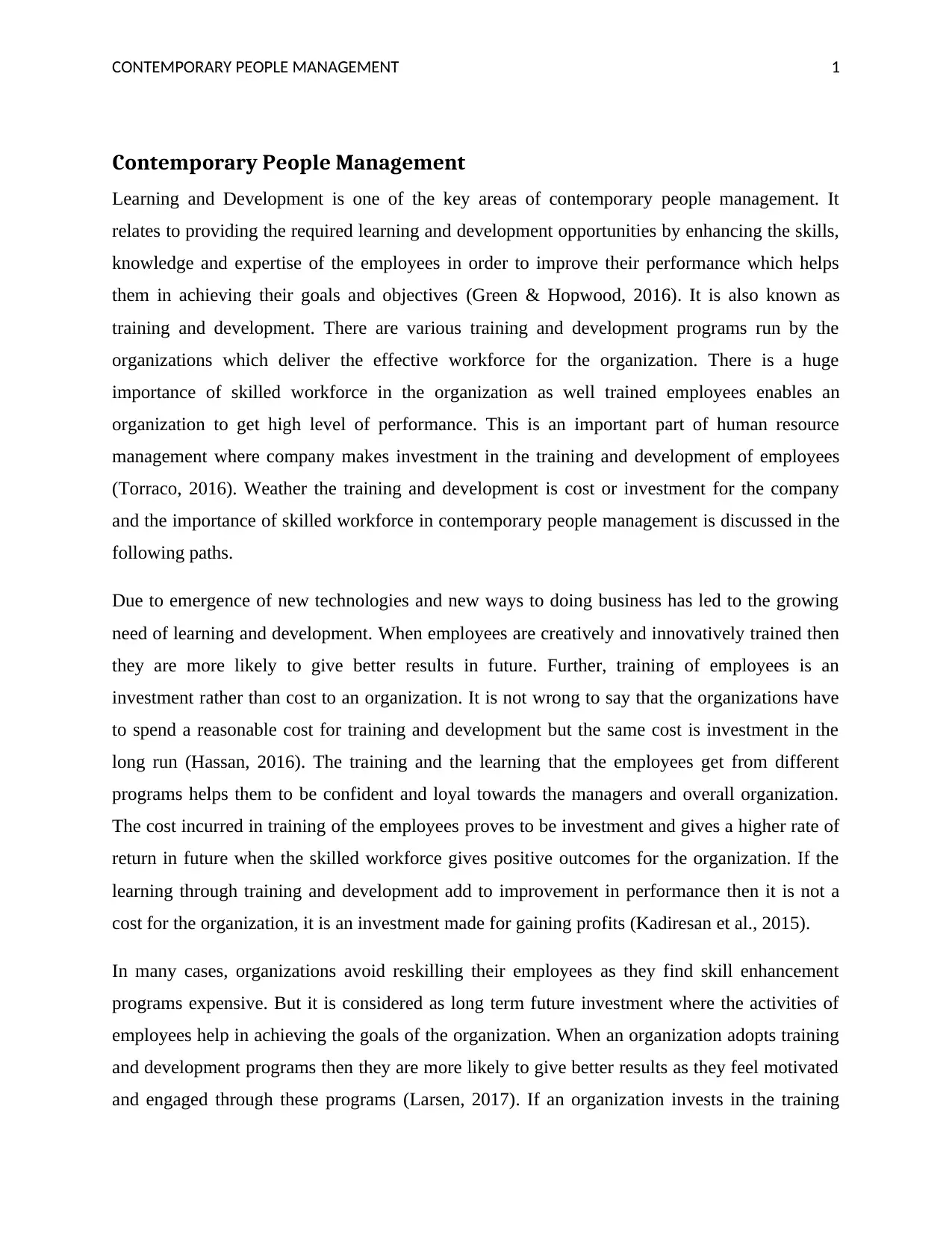
CONTEMPORARY PEOPLE MANAGEMENT 1
Contemporary People Management
Learning and Development is one of the key areas of contemporary people management. It
relates to providing the required learning and development opportunities by enhancing the skills,
knowledge and expertise of the employees in order to improve their performance which helps
them in achieving their goals and objectives (Green & Hopwood, 2016). It is also known as
training and development. There are various training and development programs run by the
organizations which deliver the effective workforce for the organization. There is a huge
importance of skilled workforce in the organization as well trained employees enables an
organization to get high level of performance. This is an important part of human resource
management where company makes investment in the training and development of employees
(Torraco, 2016). Weather the training and development is cost or investment for the company
and the importance of skilled workforce in contemporary people management is discussed in the
following paths.
Due to emergence of new technologies and new ways to doing business has led to the growing
need of learning and development. When employees are creatively and innovatively trained then
they are more likely to give better results in future. Further, training of employees is an
investment rather than cost to an organization. It is not wrong to say that the organizations have
to spend a reasonable cost for training and development but the same cost is investment in the
long run (Hassan, 2016). The training and the learning that the employees get from different
programs helps them to be confident and loyal towards the managers and overall organization.
The cost incurred in training of the employees proves to be investment and gives a higher rate of
return in future when the skilled workforce gives positive outcomes for the organization. If the
learning through training and development add to improvement in performance then it is not a
cost for the organization, it is an investment made for gaining profits (Kadiresan et al., 2015).
In many cases, organizations avoid reskilling their employees as they find skill enhancement
programs expensive. But it is considered as long term future investment where the activities of
employees help in achieving the goals of the organization. When an organization adopts training
and development programs then they are more likely to give better results as they feel motivated
and engaged through these programs (Larsen, 2017). If an organization invests in the training
Contemporary People Management
Learning and Development is one of the key areas of contemporary people management. It
relates to providing the required learning and development opportunities by enhancing the skills,
knowledge and expertise of the employees in order to improve their performance which helps
them in achieving their goals and objectives (Green & Hopwood, 2016). It is also known as
training and development. There are various training and development programs run by the
organizations which deliver the effective workforce for the organization. There is a huge
importance of skilled workforce in the organization as well trained employees enables an
organization to get high level of performance. This is an important part of human resource
management where company makes investment in the training and development of employees
(Torraco, 2016). Weather the training and development is cost or investment for the company
and the importance of skilled workforce in contemporary people management is discussed in the
following paths.
Due to emergence of new technologies and new ways to doing business has led to the growing
need of learning and development. When employees are creatively and innovatively trained then
they are more likely to give better results in future. Further, training of employees is an
investment rather than cost to an organization. It is not wrong to say that the organizations have
to spend a reasonable cost for training and development but the same cost is investment in the
long run (Hassan, 2016). The training and the learning that the employees get from different
programs helps them to be confident and loyal towards the managers and overall organization.
The cost incurred in training of the employees proves to be investment and gives a higher rate of
return in future when the skilled workforce gives positive outcomes for the organization. If the
learning through training and development add to improvement in performance then it is not a
cost for the organization, it is an investment made for gaining profits (Kadiresan et al., 2015).
In many cases, organizations avoid reskilling their employees as they find skill enhancement
programs expensive. But it is considered as long term future investment where the activities of
employees help in achieving the goals of the organization. When an organization adopts training
and development programs then they are more likely to give better results as they feel motivated
and engaged through these programs (Larsen, 2017). If an organization invests in the training
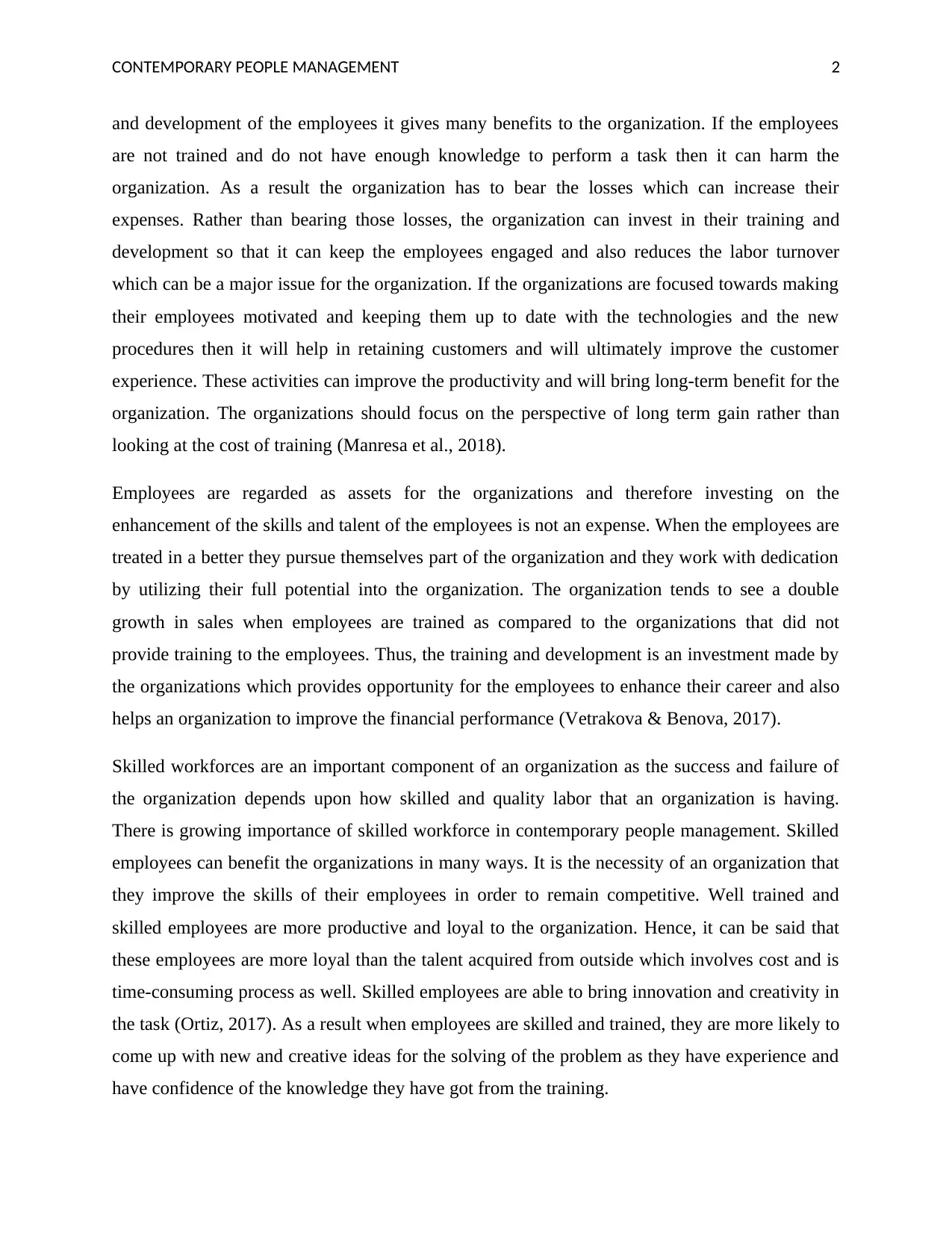
CONTEMPORARY PEOPLE MANAGEMENT 2
and development of the employees it gives many benefits to the organization. If the employees
are not trained and do not have enough knowledge to perform a task then it can harm the
organization. As a result the organization has to bear the losses which can increase their
expenses. Rather than bearing those losses, the organization can invest in their training and
development so that it can keep the employees engaged and also reduces the labor turnover
which can be a major issue for the organization. If the organizations are focused towards making
their employees motivated and keeping them up to date with the technologies and the new
procedures then it will help in retaining customers and will ultimately improve the customer
experience. These activities can improve the productivity and will bring long-term benefit for the
organization. The organizations should focus on the perspective of long term gain rather than
looking at the cost of training (Manresa et al., 2018).
Employees are regarded as assets for the organizations and therefore investing on the
enhancement of the skills and talent of the employees is not an expense. When the employees are
treated in a better they pursue themselves part of the organization and they work with dedication
by utilizing their full potential into the organization. The organization tends to see a double
growth in sales when employees are trained as compared to the organizations that did not
provide training to the employees. Thus, the training and development is an investment made by
the organizations which provides opportunity for the employees to enhance their career and also
helps an organization to improve the financial performance (Vetrakova & Benova, 2017).
Skilled workforces are an important component of an organization as the success and failure of
the organization depends upon how skilled and quality labor that an organization is having.
There is growing importance of skilled workforce in contemporary people management. Skilled
employees can benefit the organizations in many ways. It is the necessity of an organization that
they improve the skills of their employees in order to remain competitive. Well trained and
skilled employees are more productive and loyal to the organization. Hence, it can be said that
these employees are more loyal than the talent acquired from outside which involves cost and is
time-consuming process as well. Skilled employees are able to bring innovation and creativity in
the task (Ortiz, 2017). As a result when employees are skilled and trained, they are more likely to
come up with new and creative ideas for the solving of the problem as they have experience and
have confidence of the knowledge they have got from the training.
and development of the employees it gives many benefits to the organization. If the employees
are not trained and do not have enough knowledge to perform a task then it can harm the
organization. As a result the organization has to bear the losses which can increase their
expenses. Rather than bearing those losses, the organization can invest in their training and
development so that it can keep the employees engaged and also reduces the labor turnover
which can be a major issue for the organization. If the organizations are focused towards making
their employees motivated and keeping them up to date with the technologies and the new
procedures then it will help in retaining customers and will ultimately improve the customer
experience. These activities can improve the productivity and will bring long-term benefit for the
organization. The organizations should focus on the perspective of long term gain rather than
looking at the cost of training (Manresa et al., 2018).
Employees are regarded as assets for the organizations and therefore investing on the
enhancement of the skills and talent of the employees is not an expense. When the employees are
treated in a better they pursue themselves part of the organization and they work with dedication
by utilizing their full potential into the organization. The organization tends to see a double
growth in sales when employees are trained as compared to the organizations that did not
provide training to the employees. Thus, the training and development is an investment made by
the organizations which provides opportunity for the employees to enhance their career and also
helps an organization to improve the financial performance (Vetrakova & Benova, 2017).
Skilled workforces are an important component of an organization as the success and failure of
the organization depends upon how skilled and quality labor that an organization is having.
There is growing importance of skilled workforce in contemporary people management. Skilled
employees can benefit the organizations in many ways. It is the necessity of an organization that
they improve the skills of their employees in order to remain competitive. Well trained and
skilled employees are more productive and loyal to the organization. Hence, it can be said that
these employees are more loyal than the talent acquired from outside which involves cost and is
time-consuming process as well. Skilled employees are able to bring innovation and creativity in
the task (Ortiz, 2017). As a result when employees are skilled and trained, they are more likely to
come up with new and creative ideas for the solving of the problem as they have experience and
have confidence of the knowledge they have got from the training.
⊘ This is a preview!⊘
Do you want full access?
Subscribe today to unlock all pages.

Trusted by 1+ million students worldwide
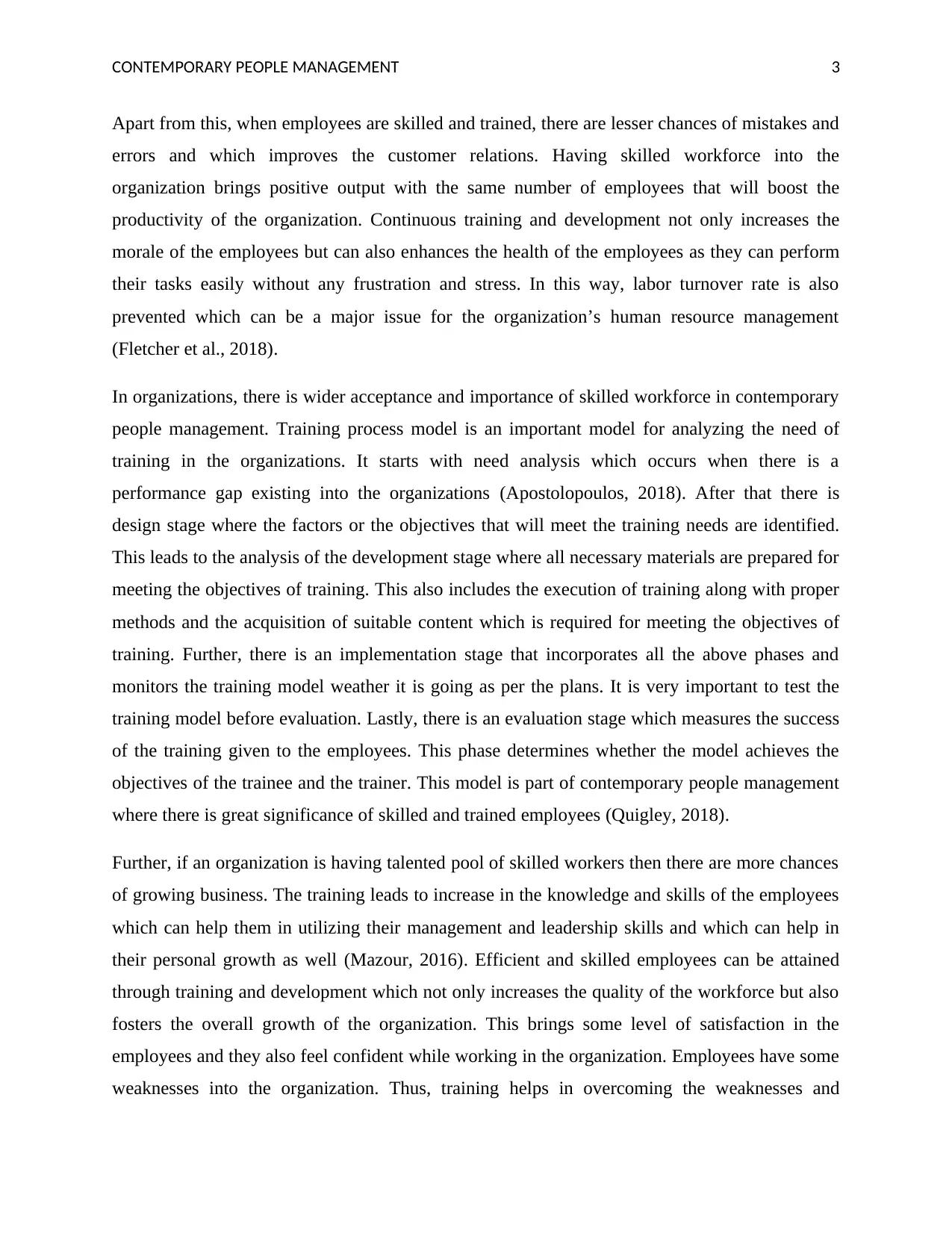
CONTEMPORARY PEOPLE MANAGEMENT 3
Apart from this, when employees are skilled and trained, there are lesser chances of mistakes and
errors and which improves the customer relations. Having skilled workforce into the
organization brings positive output with the same number of employees that will boost the
productivity of the organization. Continuous training and development not only increases the
morale of the employees but can also enhances the health of the employees as they can perform
their tasks easily without any frustration and stress. In this way, labor turnover rate is also
prevented which can be a major issue for the organization’s human resource management
(Fletcher et al., 2018).
In organizations, there is wider acceptance and importance of skilled workforce in contemporary
people management. Training process model is an important model for analyzing the need of
training in the organizations. It starts with need analysis which occurs when there is a
performance gap existing into the organizations (Apostolopoulos, 2018). After that there is
design stage where the factors or the objectives that will meet the training needs are identified.
This leads to the analysis of the development stage where all necessary materials are prepared for
meeting the objectives of training. This also includes the execution of training along with proper
methods and the acquisition of suitable content which is required for meeting the objectives of
training. Further, there is an implementation stage that incorporates all the above phases and
monitors the training model weather it is going as per the plans. It is very important to test the
training model before evaluation. Lastly, there is an evaluation stage which measures the success
of the training given to the employees. This phase determines whether the model achieves the
objectives of the trainee and the trainer. This model is part of contemporary people management
where there is great significance of skilled and trained employees (Quigley, 2018).
Further, if an organization is having talented pool of skilled workers then there are more chances
of growing business. The training leads to increase in the knowledge and skills of the employees
which can help them in utilizing their management and leadership skills and which can help in
their personal growth as well (Mazour, 2016). Efficient and skilled employees can be attained
through training and development which not only increases the quality of the workforce but also
fosters the overall growth of the organization. This brings some level of satisfaction in the
employees and they also feel confident while working in the organization. Employees have some
weaknesses into the organization. Thus, training helps in overcoming the weaknesses and
Apart from this, when employees are skilled and trained, there are lesser chances of mistakes and
errors and which improves the customer relations. Having skilled workforce into the
organization brings positive output with the same number of employees that will boost the
productivity of the organization. Continuous training and development not only increases the
morale of the employees but can also enhances the health of the employees as they can perform
their tasks easily without any frustration and stress. In this way, labor turnover rate is also
prevented which can be a major issue for the organization’s human resource management
(Fletcher et al., 2018).
In organizations, there is wider acceptance and importance of skilled workforce in contemporary
people management. Training process model is an important model for analyzing the need of
training in the organizations. It starts with need analysis which occurs when there is a
performance gap existing into the organizations (Apostolopoulos, 2018). After that there is
design stage where the factors or the objectives that will meet the training needs are identified.
This leads to the analysis of the development stage where all necessary materials are prepared for
meeting the objectives of training. This also includes the execution of training along with proper
methods and the acquisition of suitable content which is required for meeting the objectives of
training. Further, there is an implementation stage that incorporates all the above phases and
monitors the training model weather it is going as per the plans. It is very important to test the
training model before evaluation. Lastly, there is an evaluation stage which measures the success
of the training given to the employees. This phase determines whether the model achieves the
objectives of the trainee and the trainer. This model is part of contemporary people management
where there is great significance of skilled and trained employees (Quigley, 2018).
Further, if an organization is having talented pool of skilled workers then there are more chances
of growing business. The training leads to increase in the knowledge and skills of the employees
which can help them in utilizing their management and leadership skills and which can help in
their personal growth as well (Mazour, 2016). Efficient and skilled employees can be attained
through training and development which not only increases the quality of the workforce but also
fosters the overall growth of the organization. This brings some level of satisfaction in the
employees and they also feel confident while working in the organization. Employees have some
weaknesses into the organization. Thus, training helps in overcoming the weaknesses and
Paraphrase This Document
Need a fresh take? Get an instant paraphrase of this document with our AI Paraphraser
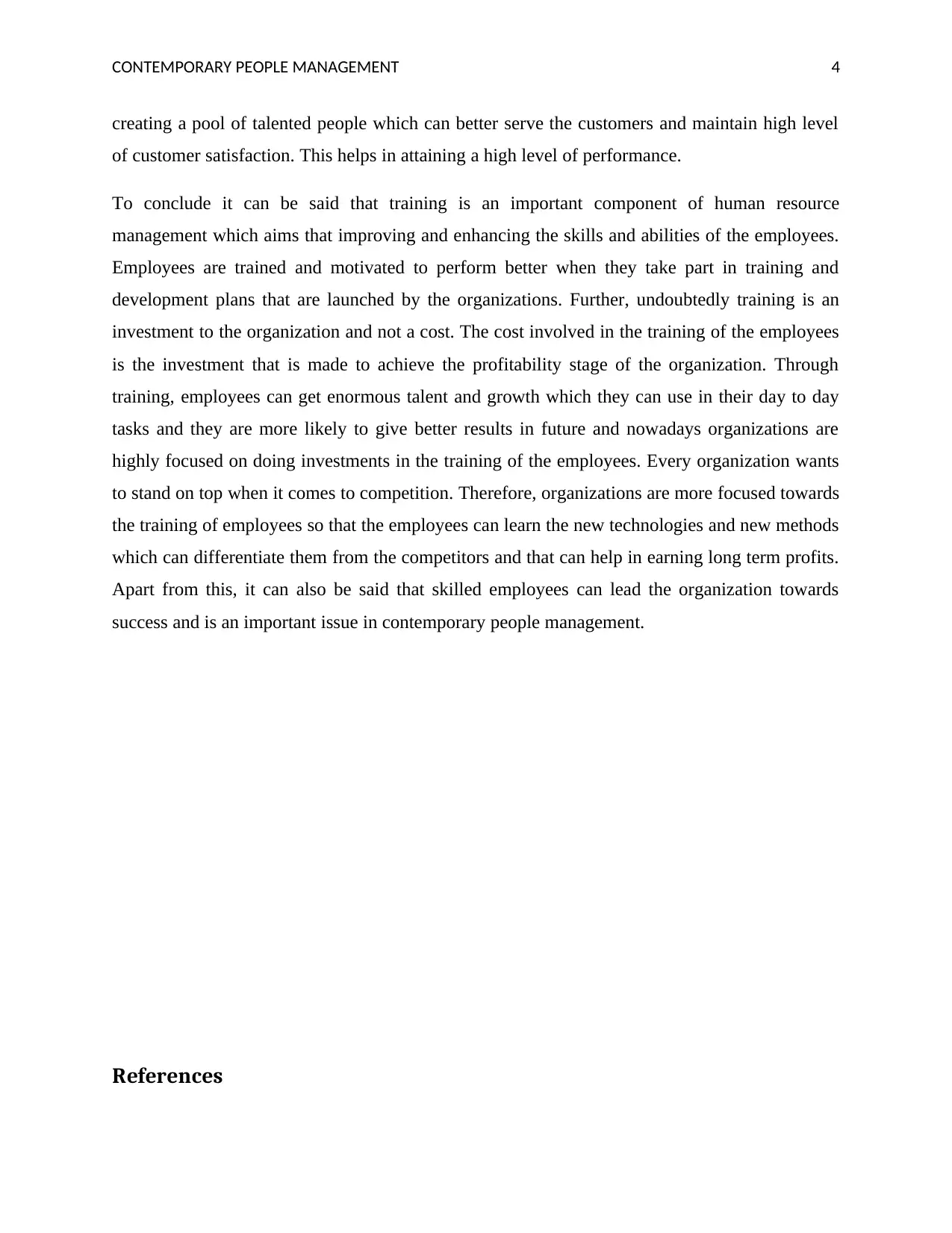
CONTEMPORARY PEOPLE MANAGEMENT 4
creating a pool of talented people which can better serve the customers and maintain high level
of customer satisfaction. This helps in attaining a high level of performance.
To conclude it can be said that training is an important component of human resource
management which aims that improving and enhancing the skills and abilities of the employees.
Employees are trained and motivated to perform better when they take part in training and
development plans that are launched by the organizations. Further, undoubtedly training is an
investment to the organization and not a cost. The cost involved in the training of the employees
is the investment that is made to achieve the profitability stage of the organization. Through
training, employees can get enormous talent and growth which they can use in their day to day
tasks and they are more likely to give better results in future and nowadays organizations are
highly focused on doing investments in the training of the employees. Every organization wants
to stand on top when it comes to competition. Therefore, organizations are more focused towards
the training of employees so that the employees can learn the new technologies and new methods
which can differentiate them from the competitors and that can help in earning long term profits.
Apart from this, it can also be said that skilled employees can lead the organization towards
success and is an important issue in contemporary people management.
References
creating a pool of talented people which can better serve the customers and maintain high level
of customer satisfaction. This helps in attaining a high level of performance.
To conclude it can be said that training is an important component of human resource
management which aims that improving and enhancing the skills and abilities of the employees.
Employees are trained and motivated to perform better when they take part in training and
development plans that are launched by the organizations. Further, undoubtedly training is an
investment to the organization and not a cost. The cost involved in the training of the employees
is the investment that is made to achieve the profitability stage of the organization. Through
training, employees can get enormous talent and growth which they can use in their day to day
tasks and they are more likely to give better results in future and nowadays organizations are
highly focused on doing investments in the training of the employees. Every organization wants
to stand on top when it comes to competition. Therefore, organizations are more focused towards
the training of employees so that the employees can learn the new technologies and new methods
which can differentiate them from the competitors and that can help in earning long term profits.
Apart from this, it can also be said that skilled employees can lead the organization towards
success and is an important issue in contemporary people management.
References
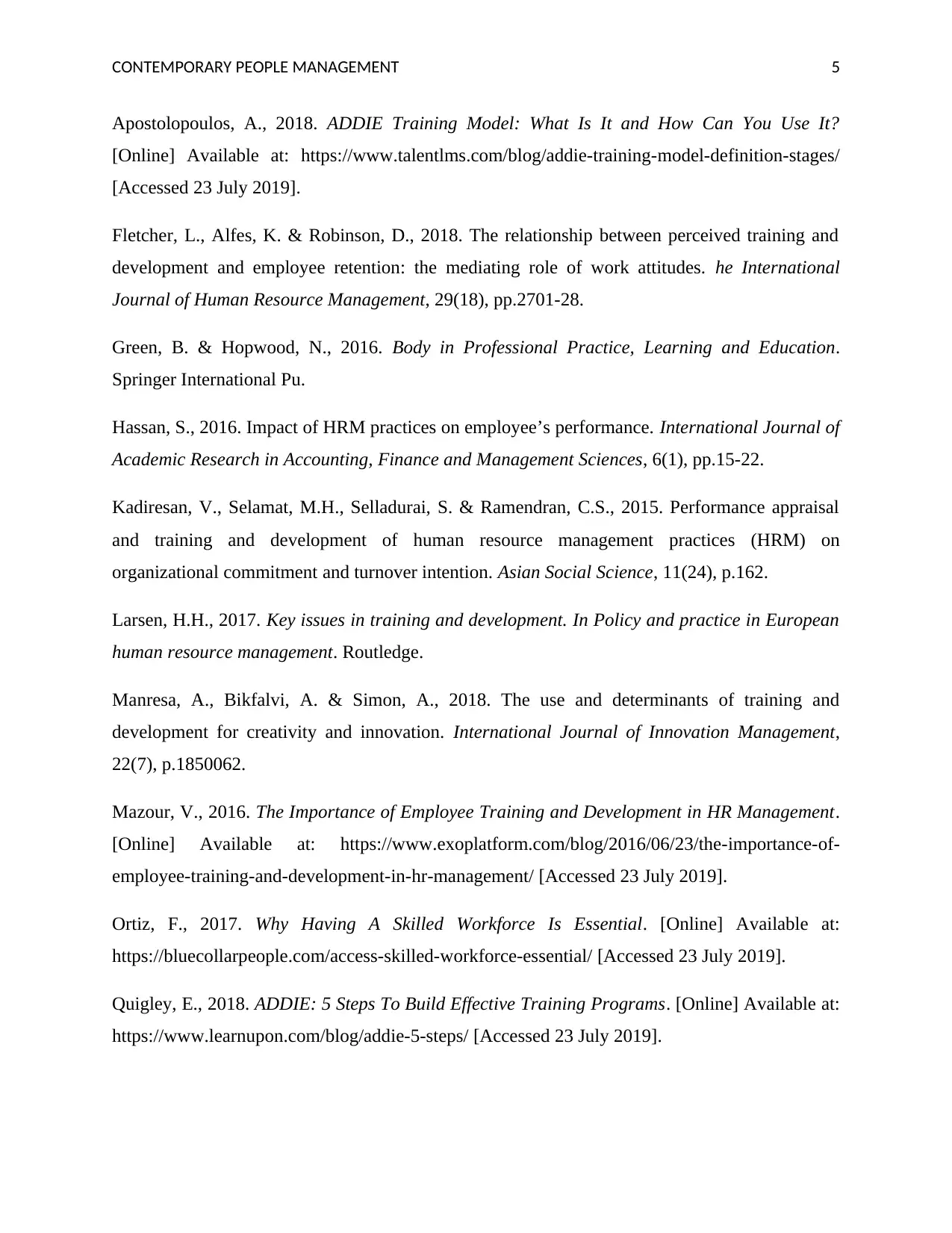
CONTEMPORARY PEOPLE MANAGEMENT 5
Apostolopoulos, A., 2018. ADDIE Training Model: What Is It and How Can You Use It?
[Online] Available at: https://www.talentlms.com/blog/addie-training-model-definition-stages/
[Accessed 23 July 2019].
Fletcher, L., Alfes, K. & Robinson, D., 2018. The relationship between perceived training and
development and employee retention: the mediating role of work attitudes. he International
Journal of Human Resource Management, 29(18), pp.2701-28.
Green, B. & Hopwood, N., 2016. Body in Professional Practice, Learning and Education.
Springer International Pu.
Hassan, S., 2016. Impact of HRM practices on employee’s performance. International Journal of
Academic Research in Accounting, Finance and Management Sciences, 6(1), pp.15-22.
Kadiresan, V., Selamat, M.H., Selladurai, S. & Ramendran, C.S., 2015. Performance appraisal
and training and development of human resource management practices (HRM) on
organizational commitment and turnover intention. Asian Social Science, 11(24), p.162.
Larsen, H.H., 2017. Key issues in training and development. In Policy and practice in European
human resource management. Routledge.
Manresa, A., Bikfalvi, A. & Simon, A., 2018. The use and determinants of training and
development for creativity and innovation. International Journal of Innovation Management,
22(7), p.1850062.
Mazour, V., 2016. The Importance of Employee Training and Development in HR Management.
[Online] Available at: https://www.exoplatform.com/blog/2016/06/23/the-importance-of-
employee-training-and-development-in-hr-management/ [Accessed 23 July 2019].
Ortiz, F., 2017. Why Having A Skilled Workforce Is Essential. [Online] Available at:
https://bluecollarpeople.com/access-skilled-workforce-essential/ [Accessed 23 July 2019].
Quigley, E., 2018. ADDIE: 5 Steps To Build Effective Training Programs. [Online] Available at:
https://www.learnupon.com/blog/addie-5-steps/ [Accessed 23 July 2019].
Apostolopoulos, A., 2018. ADDIE Training Model: What Is It and How Can You Use It?
[Online] Available at: https://www.talentlms.com/blog/addie-training-model-definition-stages/
[Accessed 23 July 2019].
Fletcher, L., Alfes, K. & Robinson, D., 2018. The relationship between perceived training and
development and employee retention: the mediating role of work attitudes. he International
Journal of Human Resource Management, 29(18), pp.2701-28.
Green, B. & Hopwood, N., 2016. Body in Professional Practice, Learning and Education.
Springer International Pu.
Hassan, S., 2016. Impact of HRM practices on employee’s performance. International Journal of
Academic Research in Accounting, Finance and Management Sciences, 6(1), pp.15-22.
Kadiresan, V., Selamat, M.H., Selladurai, S. & Ramendran, C.S., 2015. Performance appraisal
and training and development of human resource management practices (HRM) on
organizational commitment and turnover intention. Asian Social Science, 11(24), p.162.
Larsen, H.H., 2017. Key issues in training and development. In Policy and practice in European
human resource management. Routledge.
Manresa, A., Bikfalvi, A. & Simon, A., 2018. The use and determinants of training and
development for creativity and innovation. International Journal of Innovation Management,
22(7), p.1850062.
Mazour, V., 2016. The Importance of Employee Training and Development in HR Management.
[Online] Available at: https://www.exoplatform.com/blog/2016/06/23/the-importance-of-
employee-training-and-development-in-hr-management/ [Accessed 23 July 2019].
Ortiz, F., 2017. Why Having A Skilled Workforce Is Essential. [Online] Available at:
https://bluecollarpeople.com/access-skilled-workforce-essential/ [Accessed 23 July 2019].
Quigley, E., 2018. ADDIE: 5 Steps To Build Effective Training Programs. [Online] Available at:
https://www.learnupon.com/blog/addie-5-steps/ [Accessed 23 July 2019].
⊘ This is a preview!⊘
Do you want full access?
Subscribe today to unlock all pages.

Trusted by 1+ million students worldwide
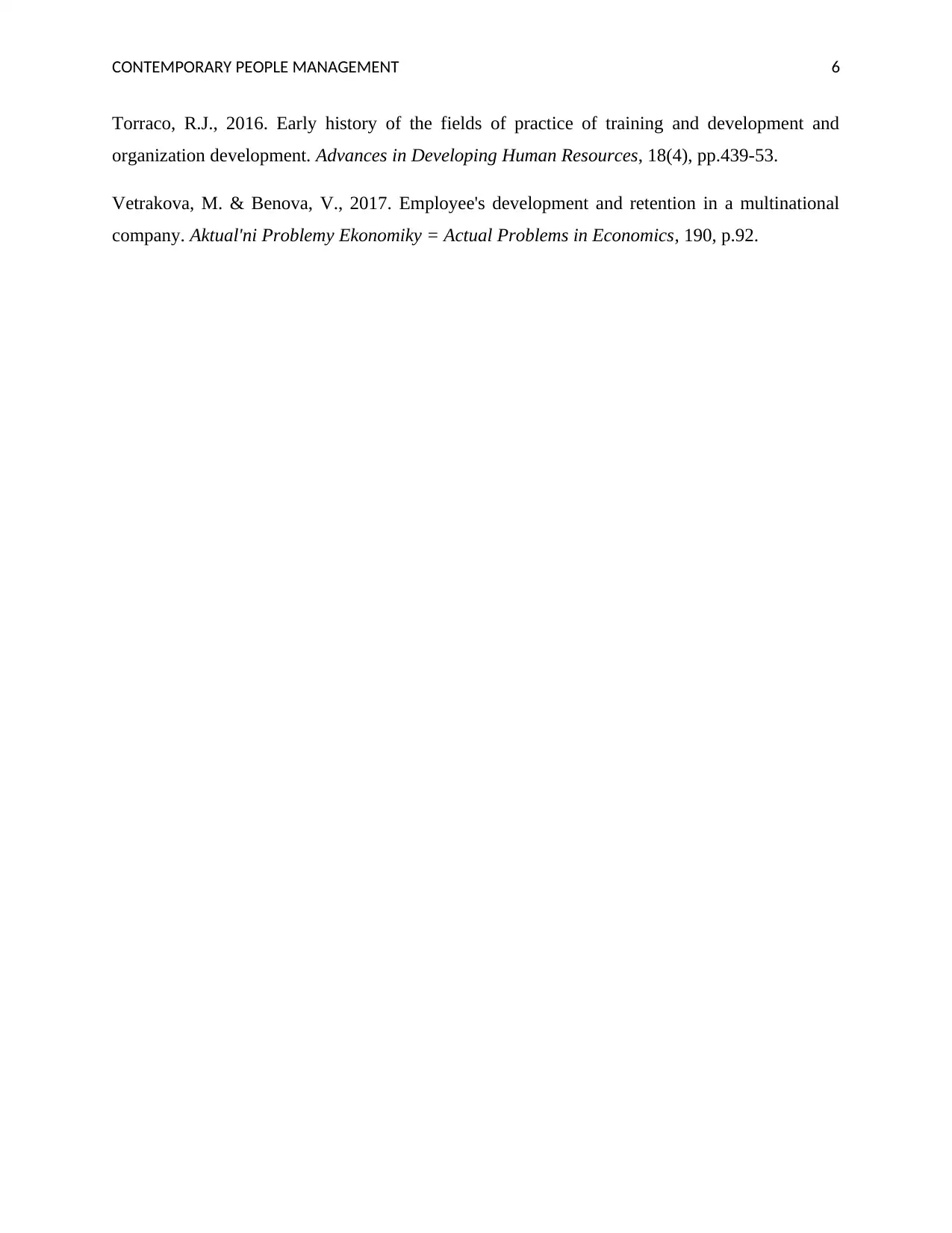
CONTEMPORARY PEOPLE MANAGEMENT 6
Torraco, R.J., 2016. Early history of the fields of practice of training and development and
organization development. Advances in Developing Human Resources, 18(4), pp.439-53.
Vetrakova, M. & Benova, V., 2017. Employee's development and retention in a multinational
company. Aktual'ni Problemy Ekonomiky = Actual Problems in Economics, 190, p.92.
Torraco, R.J., 2016. Early history of the fields of practice of training and development and
organization development. Advances in Developing Human Resources, 18(4), pp.439-53.
Vetrakova, M. & Benova, V., 2017. Employee's development and retention in a multinational
company. Aktual'ni Problemy Ekonomiky = Actual Problems in Economics, 190, p.92.
1 out of 7
Related Documents
Your All-in-One AI-Powered Toolkit for Academic Success.
+13062052269
info@desklib.com
Available 24*7 on WhatsApp / Email
![[object Object]](/_next/static/media/star-bottom.7253800d.svg)
Unlock your academic potential
Copyright © 2020–2025 A2Z Services. All Rights Reserved. Developed and managed by ZUCOL.




